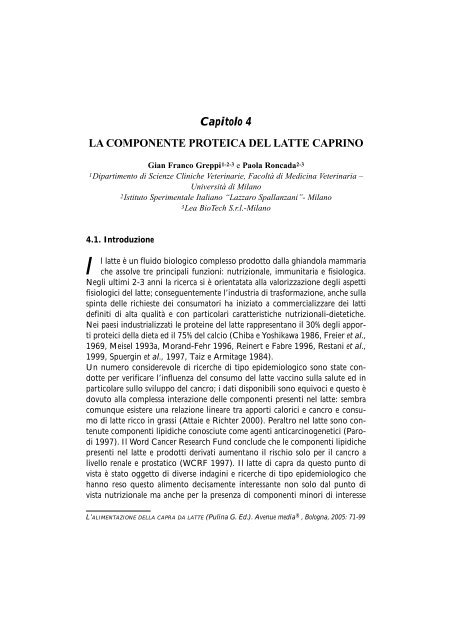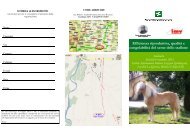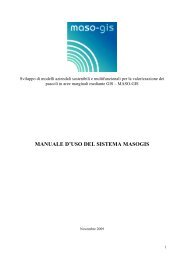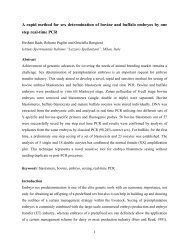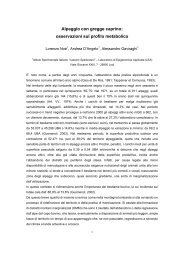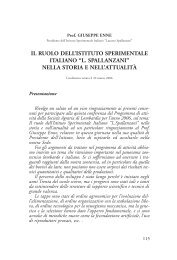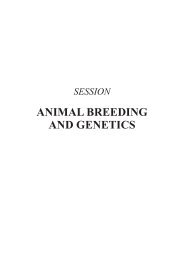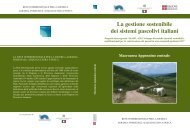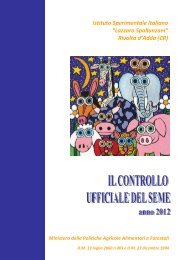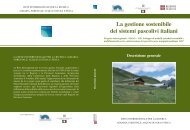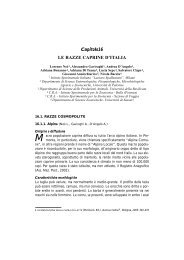latte - Istituto Sperimentale Italiano Lazzaro Spallanzani
latte - Istituto Sperimentale Italiano Lazzaro Spallanzani
latte - Istituto Sperimentale Italiano Lazzaro Spallanzani
Create successful ePaper yourself
Turn your PDF publications into a flip-book with our unique Google optimized e-Paper software.
G.F. Greppi e P. Roncada75presenti nella proteina nativa, vengono rilasciati da una proteolisi enzimatica, adesempio durante la digestione gastrica o anche semplicemente durante il trattamentotecnologico. Sin dagli anni ’80 diversi Autori hanno descritto biopeptidiattivi derivati dalle proteine del <strong>latte</strong>, e in contrasto con i biopeptidi endogenihanno da subito manifestato molteplici funzioni biologiche (Yoshikawa etal., 1988). Il <strong>latte</strong> ha acquisito una nuova valenza anche in termini nutrizionalie le esigenze degli atleti hanno riconfermato la necessità di un consumo elevatodi proteine ad alto valore biologico per mantenere un bilancio azotatopositivo nelle fasi di allenamento accompagnate da un aumento della massamuscolare (Figura 4.2). In questi casi i fabbisogni proteici aumentano da due atre volte rispetto al normale fabbisogno, e in questi casi il rischio di un affaticamentorenale per gli elevati livelli proteici è frequente; le proteine sono perquesti soggetti necessarie anche per riparare le lesioni muscolari dopo l’esercizio.Le conseguenze della intensa attività fisica sono da ricercarsi oltre al rischiodi carenze, nella formazione di radicali liberi che possono portare anche a deficienzedi tipo immunologico, negli sforzi di tipo aerobico si può avere unacarenza di ferro che limita le performances; supplementazioni di ferro possonoprodurre effetti indesiderabili. In queste situazioni il <strong>latte</strong> di capra può rappresentareun valido sussidio (Domeniconi e Blazola 1980, Swatlo et al., 1990).Nel <strong>latte</strong> sono presenti due principali frazioni proteiche, quella caseinica che risultapreponderante e quella sierica (Law e Brown 1994). Il contenuto quali-quantitativodelle diverse frazioni può dipendere da molteplici fattori: fisiologici (alimentazione,stadio della lattazione, ordine di lattazione), ambientali (clima, igiene) egenetici come la razza, la genealogia e nutrizionali (Polidori et al., 1991). Più precisamente,sono presenti sei principali proteine, quattro caseine (αs 1, αs 2, β e κ) eAFigura 4.2 - Schema di metabolismo negli atleti.
76 La componente proteica del <strong>latte</strong> caprinodue sieroproteine la β-Lattoglobulina e l’α-Lattoalbumina (Perez e Calvo 1995).La frazione proteica del <strong>latte</strong> caprino, analogamente a quella di altri ruminanti diinteresse zootecnico, è costituita prevalentemente dalle caseine che rappresentanocirca l’80% delle proteine totali (Ambrosoli et al., 1988).Analizziamo in dettaglio le caratteristiche delle principali proteine del <strong>latte</strong> considerandoalcuni aspetti: le proteine contenute in maggior quantità nel <strong>latte</strong> deiruminanti sono le tre caseine (αs 1, αs 2, β) sensibili al calcio. La caseina è una proteinaglobulare presente nel <strong>latte</strong> in dispersione colloidale, sotto forma di micelle.È caratterizzata dall’avere una parte idrofobica e una parte idrofilica polare carica;le regioni anioniche della zona polare sono responsabili della sensibilità al Ca ++ edi alcune proprietà fisico-chimiche di questa proteina (Jaubert et al., 1999). Lemicelle sono costituite da una frazione proteica e da una componente minerale(calcio, fosfato). Le caseine sono essenzialmente un gruppo di fosfoproteine specifichedel <strong>latte</strong>, che precipitano quando il <strong>latte</strong> viene acidificato a pH a 4,6-4,7 a20 °C, o per trattamento enzimatico (chimosina) o per centrifugazione ad altavelocità. Sotto il profilo chimico, le caseine risultano ricche in prolina, acido glutammicoe glutammina, mentre sono povere in glicina e acido aspartico.Tabella 4.4 - Composizione aminoacidica delle proteine del <strong>latte</strong> umano, del <strong>latte</strong> vaccinoe del <strong>latte</strong> caprino.Contenuto in mg/g Proteina Latte umano Latte vaccino Latte caprinoProteine Totali 9-15 32-34 28-32Aminoacidi IndispensabiliCisteina 20 9 9Fenilalanina 37 52 47Isoleucina 53 64 48Istidina 23 28 26Leucina 104 100 96Lisina 71 83 80Metionina 16 27 25Tirosina 46 53 38Treonina 44 51 49Triptofano 17 14Valina 51 68 61Aminoacidi non IndispensabiliAc. Aspartico 86 79 75Ac. Glutammico 190 208 209Alanina 40 35 34Arginina 36 37 29Glicina 22 21 18Prolina 95 101 106Serina 61 56 49
80 La componente proteica del <strong>latte</strong> caprinoFigura 4.8 - RP-HPLC Cromatogrammidi caseine con differentevarianti αs 1caseine VariantiB A ed F a = k caseina,b =αs 2caseina e c=β-caseina.Figura 4.9 - Elettroforesi capillare di <strong>latte</strong> dicapra a, nel tracciato b <strong>latte</strong> dicapra trattato con plasmina,con la lettera s sono indicati ipeptidi della caseina.I latti con genotipo forte al locus αs 1-caseina si caratterizzano per specificheproprietà di trasformazione casearia.a. Il contenuto di Ca totale più elevato, si ha quindi una maggiore attitudinealla coagulazione enzimatica .b. Il diametro delle micelle caseiniche è inferiore, quindi la consistenza del coaguloè più elevata.c. Il periodo di attivazione del processo di coagulazione, cioè il tempo cheintercorre fra l’aggiunta del caglio e l’indurimento del coagulo, è più bassorispetto a quello di latti di tipo nullo.d. La velocità di formazione del coagulo è più alta ed il coagulo ottenuto risultapiù consistente rispetto a quello che si forma con latti di tipo nullo.
G.F. Greppi e P. Roncada81Tabella 4.5 - Varianti genetiche delle proteine del <strong>latte</strong>.Proteina Variante Posizione dell’aminoacidoαs 1-caseina 14-26 53 59 192A MancanoB Ala Gln GluCGlyDThrE Lys Glyαs 2-caseina 33-47 50-58 130Α Glu Ala ThrΒC Gly Thr IleD MancanoTabella 4.6 - Contenuto di caseine individuali (%) per tipo genetico.Caseine αs 1αs 2β κ AltroMedio 28,35 a 0,62 a 53,74 b 15,76 1,62 aDebole 5,20 b 23,16 b 49,01 a 19,15 3,92 bNullo 1,61 c 23,98 b 52,87 b 17,07 4,46 bTabella 4.7 - Contenuto delle maggiori frazioni sieriche (%) per tipo genetico.Sieroproteine β-Lg α-La SA Lf AltroMedio 43,8 21,8 9,0 2,6 22,8Debole 45,8 23,3 7,7 1,5 21,7Nullo 50,0 23,1 7,0 1,5 18,4Le differenze quantitative tra le varianti genetiche delle singole proteine (Bramantiet al., 2003, Di Luccia et al., 1990, Enne et al., 1997, Grousclaude eMartin 1997, Noè 1995, Lambert et al., 1996), pur essendo quasi sempremolto piccole, possono influire in maniera diretta o indiretta sulle proprietà tecnologichee nutritive del <strong>latte</strong>, come evidenziato da alcuni studi sulla caseificazione(Addeo et al., 1989, Ambrosoli et al., 1988, Buchin et al., 1998, Clark eSherbon 2000, Delacroix et al., 1996, Dumond 1993, Heil et al., 1993, Pirisiet al., 1994, Remeuf 1993, Trujillo et al., 1998, Vassal 1994). Nella tabella 8sono riportate le principali ricerche sui polimorfismi delle caseine caprine.
82 La componente proteica del <strong>latte</strong> caprinoTabella 4.8 - Frequenze alleliche al locus as1 Cn nelle diverse razze caprine.Razza Paese Oss. Anno Autore A B C D E F 0Alpina F 213 1991 1 14 5 1 34 41 5Alpina IT 38 1994 6 3 26 1 5 42 10 8Alpina IT 40 1994 4 23Alpina IT 80 1991 2 - - - - 35 59 6Alpina IT 26 1995 3 13 15 - - 9 40 21Alpina IT 113 1995 7 11 29 - - 16 14 30Bionda A. IT 85 1996 3 1 3 - - 5 33 58Canaria E 74 1991 9 28 32 - - 20 - 20Corsa F 106 1989 8 6 13 - - 14 59 8Frisa IT 36 1995 3 - 3 - - 5 37 55Garganica IT 48 1994 6 39 41 5 4 - - -Garganica IT 54 1991 2 61 ---- 37 ---- - 2 -Granadina E 77 1991 9 8 25 - - 62 5 -Malaguena E 56 1991 9 - 25 - - 70 5 -Inc. Maltese IT 177 1995 3 21 38 - - 4 11 27Maltese IT 81 1991 2 33 --- 28 ---- - 11 27Maltese IT 372 1994 6 46 16 1 - 5 14 3Inc. Sarda IT 181 1995 3 20 53 - - 5 14 8Ionica IT 77 1994 6 39 27 8 - 5 1 4Marocch M 82 1995 3 21 52 4 - 9 7 6Orobica IT 70 1995 7 4 - - - 2 47 45Payoya E 39 1991 9 4 14 - - 82 - -Poitevine F 209 1989 8 5 35 - - 45 14 -Rove F 147 1989 8 12 5 - - 62 10 11Saanen F 159 1991 1 7 6 -----0,3 - 49 46 -Saanen IT 70 1991 2 5 35 -- - 45 14 -Saanen IT 50 1995 3 10 8 - 18 10 54Potevine F 302 1995 5 4 36 - - 43 9Sarda IT 115 1995 3 11 59 - - 7 14Siriana IT 241 1994 6 50 17 - - 6 16Tunisine T 86 1995 3 31 41 1 - 5 5 17Verzaschesi IT 57 1995 3 4 34 - - - 7 48Verzaschesi IT 54 1999 3 3 30 - 2 5 49 111 Grosclaude et al.; 2 Ramunno et al.; 3 Feligini et al.; 4 Caroli et al.; 5 Ricordeau et al.; 6 Chianeseet al.; 7 Meggiolaro et al.; 8 Mahé et al.; 9 Giordana et al.
G.F. Greppi e P. Roncada83Fra le diverse caseine, su tracciato elettroforetico in gel di poliacrilamide, laβ-caseina risulta essere quella quantitativamente predominante, dando originea due bande, b 1e b 2. Le due molecole proteiche differiscono tra loro perchépresentano rispettivamente 6 e 5 gruppi fosforilati (Galliano et al., 2004).Alcuni studi recenti hanno confermato che, per quanto riguarda le razze italiane,esiste un allele β−nullo associato all’allele αs 1-Cn A (Cosenza et al., 2003,Ramunno et al., 1995). Questo allele β-nullo diminuisce il contenuto diβ-caseina, ma è associato con un aumento di caseina αs 1e caseina totale. Inoltre,da analisi condotte sulle proprietà di coagulazione, si è visto che il <strong>latte</strong> prodottoda individui omozigoti β-Cn 0/0 ha tempi di coagulazione tre voltesuperiori il valore normale, la consistenza del coagulo è ridotta, la resa in formaggio(Caciotta) è inferiore (Chianese et al., 1993, Pena et al., 1998). Adoggi, gli studi svolti sull’αs 2-caseina non sono numerosi come quelli riguardantil’αs 1-caseina. Le varianti genetiche attualmente conosciute sono tre; A, B, C(Bouniol et al., 1994), e solo recentemente sono state identificate mediantetecniche elettroforetiche quali IEF e SDS-PAGE. Gli alleli differiscono fra loroper la sostituzione di un solo aminoacido legato ad un sito di fosforilazione. Illegame con l’αs 1- κ Cn non sembra essere della stessa intensità di quello esistentefra l’αs 1-Cn e la β-Cn (Cheng et al., 1993) Anche per quanto riguarda lak-caseina è stata rilevata la presenza di un polimorfismo genetico al locus k-Cn(Angiolillo et al., 2002, Di Luccia et al., 1990,Yahyauoui et al., 2003, Prinzenberget al., 2005). Sono state messe in evidenza due varianti, A e B, che differisconoprobabilmente per la sostituzione di un residuo aminoacidico. Le proprietàfisico-chimiche di questa frazione caseinica sono state identificate nellasolubilità in presenza di ioni calcio e nella sensibilità alla chimosina. Il suo contenutonel <strong>latte</strong> influenza l’inizio della coagulazione: infatti questa fase iniziasolo quando tutta la k-caseina è stata idrolizzata. Nonostante fino ad ora siastata riscontrata una forte associazione fra il locus della αs 1e quello dellaβ-caseina, si suppone che, come per i bovini, anche per i caprini esistano dellecorrelazioni fra tutti i loci caseifici (Parma et al., 1999, Parma et al., 2003).4.4. Reazione allergica e intolleranza al <strong>latte</strong>L’intolleranza alimentare è una reazione anormale da parte dell’organismo chesi verifica dopo l’assunzione di un alimento indipendentemente dal meccanismopatogenetico. Si definisce come allergia l’insieme delle manifestazioni cliniche(rinite, asma, eczema,...) che appaiono secondariamente dopo il contatto di un
84 La componente proteica del <strong>latte</strong> caprino“antigene” (acaro, polline, <strong>latte</strong> di vacca, maiale, orzo...) con un anticorpo specificodi una classe di immunoglobuline dette epsilon: IgE che si fissano su uncerto numero di cellule (mastociti e basofili polinucleati). Il contatto di un antigenee la sua IgE specifica ha come effetto la produzione di alcuni mediatoricome l’istamina che causa una risposta immunitaria eccessiva, da cui deriva iltermine ipersensibilità. L’istamina in forma libera è contenuta in quantitàapprezzabili nel tonno, nello sgombro, in altri pesci a carne scura e nei formaggistagionati; altri alimenti quali le fragole, i pomodori, l’albume, etc. hanno invecela capacità di indurre la liberazione di istamina; ciò avviene, con meccanismiparticolari, anche con le lecitine che sono presenti nella frutta, nei cereali ed inmolte verdure (Belloni-Businico et al., 1999, Carbonaro et al., 1966, Cartoniet al., 1999).Questi agenti biologicamente attivi (ma anche altri: antiossidanti, antimicrobici,tossine, micro organismi, etc.) se presenti in grande quantità, possono provocareuna grande varietà di sintomi potenzialmente in tutti gli individui, inragione però di ogni singolo limite di sensibilità. I soggetti con mucosegastro-intestinali e respiratorie iper reattive e quelli con cute irritabile hanno unlimite basso e reagiscono pertanto anche in presenza di modeste quantità diantigene (agente biologicamente attivo) presente nel cibo causando sintomatologietipiche dell’allergia alimentare. Nel <strong>latte</strong> vaccino vi sono almeno 20 proteinediverse, ma solo 5 sarebbero interessanti dal punto di vista allergenico: lasieroalbumina, la gammoglobulina e l’alfalattoglobulina (termolabili e quindifacilmente desensibilizzabili) e la betalattoglobulina e la caseina (termostabili eresistenti all’azione degli enzimi proteolitici del digerente). La proteina del <strong>latte</strong>che risultasse indigerita nel neonato manterrebbe sostanzialmente inalterata lasua struttura (la catena peptidica di cui è formata non si fraziona nelle sue componenticostitutive (aminoacidi) per l’insufficiente attacco enzimatico delle proteasio per la mancanza nell’intestino dell’enzima specifico) e verrebbe riconosciutacome se fosse un corpo estraneo (antigene). La quantità di materiale antigenicoassorbita viene limitata da barriere anatomiche (muco, epitelio) e/o eliminatada barriere immunologiche per combinazione sulla superficie epitelialedegli antigeni con le immuno globuline secretorie (IgA). In tal modo si produceun importante ruolo protettivo riducendo la penetrazione allergenica poichégli antigeni (proteine del <strong>latte</strong>) non hanno accesso ai sistemi immuni IgG eIgE. Se le barriere vengono indebolite da processi infiammatori o da deficit diIgA la penetrazione di grandi quantità di antigeni può generare sensibilizzazioneed allergia nei soggetti atopici. In generale nel neonato non esistono intolleranzevere al <strong>latte</strong> materno, se si escludono malattie metaboliche gravi (fenil-
G.F. Greppi e P. Roncada85cheturia, galactosemia) o manifestazioni che giustificano l’interruzione dell’allattamento(ittero, diarrea, costipazione). Il <strong>latte</strong> vaccino, tuttavia, a volte nonè tollerato dai bambini in allattamento poiché alcune sue componenti proteichetermostabili (beta-lattoglobulina e caseina) vengono assorbite pressoché intattee riconosciute come proteine “estranee” da un organismo ipersensibile. L’intolleranzaal <strong>latte</strong> di vaccino viene convenzionalmente definita come APLV(allergia alle proteine del <strong>latte</strong> vaccino) o anche come intolleranza alle proteinedel <strong>latte</strong> vaccino (IPLV) e può interessare una percentuale variabile tra il 2 e il4% della popolazione. In ambito pediatrico, si calcola comunque che la frequenzatra l’1% e l’8%, con una predisposizione atopica della popolazione generalevariabile tra il 15% e il 20%. L’allergia al <strong>latte</strong> vaccino rappresenta comunquela prima causa delle allergie digestive nei Paesi industrializzati. L’esistenzadelle intolleranza al <strong>latte</strong> vaccino deve essere destinata in due tipi intolleranza:di origine immunologica e di tipo non immunologico. Fra queste ultime intolleranzela più nota è quella al lattosio dovuta ad una carenza di lattasi intestinale.In verità non tutti i disturbi e le sintomatologie riscontrabili nell’individuosensibile a seguito della ingestione di alcuni cibi sono riconducibili ad una allergiaalimentare (eziologia immunologica provata o probabile) poiché soventel’eziologia immunologica è decisamente improbabile ed in questi casi è piùopportuno parlare di intolleranza alimentare o pseudoallergia o idiosincrasia.Nelle APLV possiamo distinguere diverse tipi di allergia: di tipo I con una ipersensibilitàimmediata che comporta (schok anafilattico, orticaria, crisi asmatiche,disturbi digestivi gravi), nelle APLV di tipo III che comportano reazionidi tipo immunologico complesse sono caratterizzate da enteropatie ed emoraggieinterne. Mentre nelle APLV di tipo IV si osserva una ipersensibilità ritardatache causa una diarrea cronica. Le manifestazioni cliniche delle APLV sonomolto diverse e possono essere acute o ritardate digestive o estradigestive. Ilrischio di schok anafilattico è solitamente raro, ma può interessare circa il 10%dei soggetti APLV; i disturbi digestivi possono essere sia acuti che cronici; mentrele sintomatologie extradigestive descritte sono essenzialmente di tipo cutaneo(dermatiti, orticaria), respiratorie (asma), si possono verificare però, anchese con minore frequenza, disturbi renali, alterazioni ematiche e manifestazionia carico del sistema nervoso centrale ma anche di tipo neurologico.Il carattere proteiforme della sintomatologia clinica e la scarsità di criteri diagnosticispecifici (IgE totali e specifiche sono un criterio diagnostico solo nelcaso di APLV di tipo I, la biopsia intestinale ed i test di permeabilità intestinalesono difficili ed interessano solo le forme enteroepatiche). Vi sono ovviamentedei fattori predisponenti che possono favorire la comparsa delle sinto-
86 La componente proteica del <strong>latte</strong> caprinomatologie da IPLV e che sono correlati sia ad una certa ereditabilità quando infamiglia sono già stati registrati fenomeni allergici, sia all’assunzione precoce di<strong>latte</strong> vaccino (fresco od in polvere) nei primissimi giorni, sia infine all’insorgenzadi gastroenteriti entro i primi tre mesi di vita: come già accennato, infatti,una malattia infiammatoria intestinale aumenta la permeabilità epiteliale e diconseguenza il rischio di reazione da intolleranza o da vera e propria allergia.Se i primi tre mesi sono certamente ad alto rischio, poiché oltre un quarto deilattanti che hanno sofferto di gastroenterite manifesta anche il sopraggiungeredi sintomatologie tipiche della IPLV, è peraltro vero che la percentuale di IPLVche si manifesta a seguito di gastroenteriti, patite entro l’anno e fino ai 3 annid’età, mantiene una importante significatività; vi è da dire, tuttavia, che con l’avanzaredell’età del bambino aumentano le possibilità di alimentazione differenziataed alternativa al <strong>latte</strong> che risulta invece indispensabile nei primi mesi divita. Le poche esperienze realizzate sono particolarmente incoraggianti perl’impiego del <strong>latte</strong> caprino nell’alimentazione umana (Dore et al., 1993).
G.F. Greppi e P. Roncada87Bibliografia1. Addeo F., Masi P., Perna A.M., Ciafarone N., Moio L., Tripaldi C. (1987). Proprietàfunzionale dei latti caprini selezionati in base al tipo di variante genetica di caseina αs1.Il Vergaro, 7: 36-40.2. Addeo F., Masi P., Rubino R. (1989). The aptitude of caprine milk to cheese-making.Relationship between αs 1casein content and rheological properties of curd and cheese.Agriculture. Programme de recherche Agrimed. L’évaluation des ovins et descaprins. Méditerranéens. Récueils des communications. Commission des CommunautésEuropéennes. Luxembourg, 291-311.3. Addeo F., Mauriello L., Di Luccia A. (1988). A gel electrophoretic study of caprinecasein. J. Dairy Res., 55: 413-421.4. Ahrne L., Bjorck L. (1985). Effect of the lactoperoxidase system on lipoprotein lipasemilk and receptor oligosaccharides. J. Infect. Dis. 1986; 153: 232-237.5. Albertini A., Mentasti T., Moretti V.M., Bellagamba F., Luzzana U., Valfre F. (1999).Occurrence of free D-amino acids in milk from food-producing animals. Milchwissenschaft.51(3). 1996. 127-129.6. Ambrosoli R., Di Stasio L., Mazzocco P. (1988). Content of αs 1-casein and coagulationproperties in goat milk. J. Dairy Sci.. 71(1): 24-28.7. Angiolillo A., Yahyaoui M.H., Sanchez A., Pilla F., Folch J.M. (2002). Short communication:characterization of a new genetic variant in the caprine kappa-casein gene.J Dairy Sci. Oct; 85(10): 2679-80.8. Aschaffenburg R., Drewrey J. (1955). Occurence of different β-lactoglobulins incow’s milk. Nature 176: 218-219.9. Attaie R., Richter R.L.(2000). Size distribution of fat globules in goat milk. J DairySci. May; 83(5): 940-4.10. Awiatlo N., O’Connors D.L., Andrews J., Picciano M.F. (1990). Relative folate bioavaibilityfrom diets containing human, bovine and goat milk. J.Nutr. 120, 172-177.11. Bellioni-Businco B., Paganelli R., Lucenti P., Giampietro P.G., Perborn H., BusincoL. (1999). Allergenicity of goat’s milk in children with cow’s milk allerg. J Allergy ClinImmunol. Jun; 103(6): 1191-4.12. Bevilacqua C., Ferranti P., Garro G., Veltri C., Lagonigro R., Leroux C., Pietrola E.,Addeo F., Pilla F., Chianese L., Martin P. (2002). Interallelic recombination is probablyresponsible for the occurrence of a new alpha(s1)-casein variant found in the goatspecies. Eur J Biochem. 2002 Feb; 269(4): 1293-303.13. Bini L., Roncada P. (1999).Il progetto Proteoma. Atti de 34° Simp. Int. di zootecnia,Milano, Cnr.
88 La componente proteica del <strong>latte</strong> caprino14. Birkbeck J.A. (1984). Goat’s milk in infant nutrition. NZ. Med.J. 97: 413-414.15. Bjorck L. (1976). An immobilized two-enzyme system for the activation of the lactoperoxidaseantibacterial system in milk. Biotechnology & Bioengineering. 18(10):1463-1472.16. Bjorck L. (1978). Antibacterial effect of the lactoperoxidase system onpsychotrophicbacteria in milk. Journal Dairy Research. 45(1): 109-118.17. Blanc D. (1982). Les protéines du lait à activité enzymatique et hormonale. Le lait 62:350-395.18. Boulanger A., Grosclaude F., Mahé M.F. (1984). Polymorphisme des caséines α s1etαs 2de la chèvre, capra hircus. Génét. Sél. Évol., 16: 157-176.19. Bouniol C., Brignon G., Mahé M.F., Printz C. (1993). Characterisation of goatαs 2-casein A and B; further evidence of the phosphorylation code of caseins. Prot. Seq.Data Anal., 5: 213-218.20. Bouniol C., Brignon G., Mahé, M.F., Printz C. (1994). Biochemical and geneticanalysis of variant C of caprine αs 2-casein (Capra hircus). Anim. Genet., 25: 173-177.21. Boutinaud M., Jammes H.(2004) Growth hormone increases Stat5 and Stat1 expressionin lactating goat mammary gland: a specific effect compared to milking frequency.Domest Anim Endocrinol Nov; 27(4): 363-78.22. Boyazoglu J., Morand-Fehr P. (2001). Mediterranean dairy sheep and goat productsand their quality. A critical review. Small Rumin. Res. Apr; 40(1): 1-11.23. Bramanti E., Sortino C., Onor M., Beni F., Raspi G. (2003). Separation and determinationof denatured alpha(s1)-, alpha(s2)-, beta- and kappa-caseins by hydrophobicinteraction chromatography in cows’, ewes’ and goats’ milk, milk mixtures and cheeses.J Chromatogr A. Apr 25; 994(1-2): 59-74.24. Brantl V., Teschemacher H., Henschen A., Lottspeich F. (1979). Novel opioid peptidesderived from casein (beta-casomorphins). Isolation from bovine casein peptone.Hoppe Seylers Z Physiol Chem. Sep;360(9): 1211-6.25. Brignon G., Mahé M.F., Grosclaude F., Ribadeau Dumas B. (1989). Sequence ofcaprine αs 1-casein and characterization of those of its genetic variants which aresynthesized at a high level, αs 1-Cn A, B and C. Protein Seq. Data Anal., 2: 181-188.26. Brignon G., Mahé M.F., Ribadeau Dumas B., Mercier J.C., Grosclaude F. (1990).Two of the three genetic variants of goat αs 1-casein which are synthesized at a reducedlevel have an internal deletion possibly due to altered RNA splicing. Eur. J. Biochem.,193: 237-241.27. Brown R.W., Mickelson M.N. (1979). Lactoperoxidase, thiocyanate, and free cystinein bovine mammary secretions in early dry period and at the start of lactation and theireffect on Streptococcus agalactiae growth. American J. Veterinary Research. 40(2):250-25.
G.F. Greppi e P. Roncada8928. Buchin S., Duboz G., Le Quéré J.L., Grappin R. (1998). Développement des caractéristiquesbiochimiques et sensorielles des fromages de chèvre. Etude interspèce paréchange de la matière grasse et du lait écrémé de laits de vache et de chèvre. Lait 78:673-687.29. Bulletin FIL-IDF (1986). n. 202. Production and utilization of ewe’s and goat’s milk.30. Carbonaro M., Bonomi F., Iametti S., Cappelloni M., Carnovale E. (1996). Aggregationof whey proteins in raw and heat-treated milks: possible nutritional consequences.Ital. Biochem. Soc. Trans. 7, 266.31. Cartoni G., Coccioli F., Jasionowska R., Masci M. (1999). Determination of cows’milk in goats’ milk and cheese by capillary electrophoresis of the whey protein fractions.Journal of Chromatography. 846(1-2). June 18. 135-141.32. Casper J.L., Wendorff W.L., Thomas D.L. (1998). Seasonal changes in protein compositionof whey from commercial manufacture of caprine and ovine specialty cheeses.J. Dairy Sci., 81: 3117-3122.33. Castillo M.Z., Payne F.A., Hicks L., Laencina J.S., Lopez M.B. (2003). Modellingcasein aggregation and curd firming in goats’ milk from backscatter of infrared light.J Dairy Res. Aug; 70(3): 335-48.34. Cattaneo T.M.P., Nigro F., Greppi G.F. (1996). Analysis of cow, goat and ewe milkmixtures by Capillary Zone Electrophoresis (CZE): Preliminary approach. Milchwissenschaft.51(11): 616-619.35. Chandan R.C., Perry R.M., Shahani K.M. (1968). Lyzozyme, lipase and ribonucleasein milk of various species. J. Dairy Sci. 51: 606-607.36. Chang C.S. Sinclair R., Khalid S., Yamazaki I., Nakamura S., Powers L. (1993). Anextended X-ray absorption fine structure investigation of the structure of the activesite of lactoperoxidase. Biochemistry. 32(11): 2780-2786.37. Chianese L., Garro G., Ferranti P., Malorni A., Laezza P., Ferranti P., Addeo F.(1996). Occurence of five αs 1-casein variant. J. Dairy Res., 63: 49-59.38. Chianese L., Garro G., Nicolai M.A., Mauriello R., Ferranti P., Rizzano R., CappuccioU., Laezza P., Addeo F. (1993). De nature of β casein heterogeneity in caprinemilk. Lait, 73: 533-547.39. Chiba H., Yoshikawa M. (1986). Protein Tailoring for Food and Medical Uses. Eds.,M. Dekker N.Y.40. Choick W.S. (1998). Role of the Insulin-like growth factors and their binding proteinsin lactation. J. Dairy Sci., 81: 1769-1777.41. Clark S., Sherbon J.W. (2000). Genetic variants of alphas1-CN in goat milk: Breeddistribution and associations with milk composition and coagulation properties. SmallRuminant Research. 38(2). October, 135-143.
90 La componente proteica del <strong>latte</strong> caprino42. Cosenza G., Illario R., Rando A., di Gregorio P., Masina P., Ramunno L. (2003).Molecular characterization of the goat CSN1S1(01) allele. J Dairy Res. May; 70(2):237-40.43. Dall’Olio S, Davoli R., Russo V. (1989). Una nuova variante di caseina caprina. Sci.Tecn. Latt.-cas. 40: 24-28.44. Dall’Olio S., Davoli R., Tedeschi M. (1988). Contributo allo studio della caseinacaprina mediante cromatografia. Sci. Tec. Latt.-cas., 39: 167-178.45. Darnthon Hill I., Coveney J., Davery G.R. (1987). Goat milk-nutritional and publichealth aspects: a review. Food Technol Aust. 39: 568-572.46. Davis S.R., Collier R.J. (1983). Mammary blood flow and regulation of substrate supplyfor milk synthesis. J. Dairy Sci., 68: 1041-1058.47. Delacroix-Buchet A., Degas C., Lamberet G., Vassal L. (1996). Influence des variantsAA e FF de la caséine α s1caprine sur le rendement fromager et les caractéristiques sensoriellesdes fromages. Lait 76: 217-241.48. Di Gregorio P., Rando A., Ramunno L., Masina P., Pieragostini E. (1989). Polimorfisminelle regioni del DNA che contengono i geni delle caseine di pecora e capra. AttiXXIV Simp. Int. di Zootecnia, 275-282.49. Di Luccia A., Mauriello R., Chianese L., Moio L., Addeo F. (1990). k-casein polimorphismin caprine milk. Tecn. Latt.-cas., 41(4): 305-314.50. Domeniconi D., Blazola F. (1980). Considerazioni sull’impiego del <strong>latte</strong> di capra nell’alimentazioneumana. Riv. Sc. Ital. Sci. Alim: 1: 33-36.51. Dore A., Enne G., Oggiano R. (1993). Il <strong>latte</strong> di capra nella dietoterapia dei lattantiaffetti da IPLV (Intolleranza alle proteine del <strong>latte</strong> vaccino). Atti V Simp. Int. “La qualitànelle produzioni dei piccoli ruminanti”, Varese, 79-82.52. Dumontet C., Rousset B. (1983). Identification, purification, and characterization ofa non-heme lactoperoxidase in bovine milk. J. Biological Chemistry. 258(23):14166-14172.53. Ekstrand B., Bjorck L. (1986). Fast protein liquid chromatography of antibacterialcomponents in milk. Lactoperoxidase, lactoferrin and lysozyme. J. Chromatography.358(2): 429-433.54. Enne G., Feligini M., Greppi G.F., Iametti S., Pagani S. (1997). Gene frequencies ofcaprine αs 1-casein polymorphism in dairy goat. Proc. of IDF Seminar “Milk ProteinPolymorphism”, Palmerston North, New Zealand. Pub. International Dairy Federation,Brussels (Belgium), 275-279.55. Feligini M., Parma P., Aleandri R., Greppi G.F., Enne G. (1998). PCR-RFLP test fordirect determination of β-lactoglobulin genotype in Sarda sheep. Animal Genetics, 29:473-474.
G.F. Greppi e P. Roncada9156. Feligini M., Civardi G., Pasquini M., Greppi G.F., Enne G. (1995). Caratterizzazionedella popolazione caprina verzaschese al locus αs 1-caseina. Atti Conv. Naz. “Parliamodi ....produzione e trasformazione del <strong>latte</strong>”. Fossano (Cuneo), 19-20 Ottobre1995: 211-214.57. Feligini M., Pasquini M., Greppi G.F., Enne G. (1996). Polymorphism at the locusalfas 1casein in some autochthonous goats. Food and health. Role of animal products.125-128. Ed. Elsevier.58. Ferrari R.P., Laurenti E., Cecchini P.I., Gambino O., Sondergaard I. (1995). Spectroscopicinvestigations on the highly purified lactoperoxidase Fe(III)-heme catalyticsite. J. Inorganic Biochemistry. 58(2): 109-127.59. Fox P.F. (1992). Advanced Dairy Chemestry. Proteins. ed Elsevier London.60. Freier S., Kletter B., Gerv I. (1969). Intolerance to milk protein. J. of Pediatry, 75:623-631.61. Galliano F., Saletti R., Cunsolo V., Foti S., Marletta D., Bordonaro S., D’Urso G.(2004). Identification and characterization of a new beta-casein variant in goat milkby high-performance liquid chromatography with electrospray ionization mass spectrometryand matrix-assisted laser desorption/ionization mass spectrometry. RapidCommun Mass Spectrom.; 18(17): 1972-82.62. Gaya P., Medina M., Nunez M. (1991). Effect of the lactoperoxidase system on Listeriamonocytogenes behavior in raw milk at refrigeration temperatures. Applied &Environmental Microbiology. 57(11): 3355-3360.63. Gerstberger R., Schuetz H., Olsson K. (1997). The goat mammary gland as a targetorgan for atrial natriuretic peptide. Acta Physiologica Scandinavica. 160(1): 9-14.64. Gomes A.M.P., Malcata F.X. (1998). Development of probiotic cheese manufacturedfromgoat milk: Response surface analysis via technological manipulation. Journal ofDairy Science. 81(6). June, 1492-1507.65. Gothefors L., Marklund S. (1975). Lactoperoxidase activity in human milk and in salivaof newborn infants. Infection & Immunity. 11(6): 1210-1215.66. Greppi G.F., Roncada P., Feligini M., Bossi A., Enne G. (1997). Caratterizzazione dellaLattoferrina in differenti specie animali. XII Cong. Naz. ASPA, PISA, Giugno 1997.67. Grosclaude F., Mahé M.F., Brignon G., Di Stasio L., Jeunet R. (1987). A Mendelianpolymorphism underlying quantitative variations of goat α s1-casein. Génét. Sél. Évol.,19: 399-412.68. Grosclaude F., Martin P. (1997). Casein polymorphisms in the goat. Milk proteinpolymorphism FIL-IDF Palmerston North, New Zealand 241-253.69. Grosclaude F., Ricordeau G., Martin P., Remeuf F., Vassal L., Bouillon J. (1994). Dugène au fromage: le polymorphisme de la caséine α s1caprine, ses effets, son évolution.INRA Prod. Anim., 7: 3-19.
92 La componente proteica del <strong>latte</strong> caprino70. Hadjipanayiotou M. (1995). Composition of ewe, goat and cow milk and of colostrumof ewes and goats. Small Ruminant Research. 18(3): 255-262.71. Heil F., Dumond J.P. (1993). Carastéristiques organoleptiques du fromage de chévrefabriqué à partir de laits contenant des variants génétiques différents de la caseine α -s1.Le Lait 73: 559-556.72. Herrero-Martinez J.M., Simo-Alfonso E.F., Ramis-Ramos G., Gelfi C., Righetti P.G.(2000). Determination of cow’s milk and ripening time in nonbovine cheese by capillaryelectrophoresis of the ethanol-water protein fraction. Electrophoresis. 21(3):633-640.73. Heukeshoven J., Dernick R. (1988). Improved silver staining procedure for fast stainingin PhastSystem Development Unit. I. Staining of sodium dodecyl sulfate gels.Electrophoresis. 1988. 9: 28-32.74. Hossaini H.J., Olsson K. (1996). Responses to systemic angiotensin II in lactating andnon-lactating goats. Regulatory Peptides. 66(1-2): 123-126.75. Houdebine L. M. (1995). The production of pharmaceutical proteins from the milkof transgenic animals. Reproduction, Nutrition, Development. 35(6): 609-617.76. Hulea S.A., Mogos S., Matei L (1989). Interaction of lactoperoxidase with enzymesand immunoglobulins in bovine milk. Biochemistry International. 19(6): 1173-81,1989.77. Iametti S., Feligini M., Dimartino S., Sessa F., Enne G. (2000). Frequency ofαs 2-casein variants in the italian goat breed Verzaschese. XXXV Simp. Int. Zootecnia“Produzioni animali di qualità ed impatto ambientale nel sistema mediterraneo”,Ragusa, 25 maggio 2000.78. Iametti S., Sessa F., Feligini M., Greppi G.F., Enne G., Pagani S. (1999). Frequencyαs 1-casein variants in Italian goat breed Sarda and Verzaschese. Ital. J. Food Sci., 3:249-255.79. Iametti S., Testa D., Pagani S., Greppi G.F., Feligini M., Enne G. (1996). IEF eRP-HPLC per la caratterizzazione del <strong>latte</strong> caprino. Atti XIII Congr. Naz, SIPAOC,Varese, 249-252.80. Jann O.C, Prinzenberg E.M, Luikart G., Caroli A., Erhardt G. (2004). High polymorphismin the kappa-casein (CSN3) gene from wild and domestic caprine speciesrevealed by DNA sequencing. J Dairy Res. May; 71(2): 188-95.81. Jansa-Pérez M., Leroux C., Sanchez Bonastre A., Martin P. (1994). Occurence of aline sequence in the 3’ UTR of the goat αs 1-casein E allele associated with a reducedprotein synthesis. Gene 147: 179-187.82. Jaubert A., Durier C., Kobilinsky A., Martin P. (1999). Structural organization of thegoat casein micelle: Effect of the physico-chemical environment (pH, temperature,ionic strength) on its mineral and protein composition. International Dairy Journal.9(3-6). March-June, 369-370.
G.F. Greppi e P. Roncada9383. Jaubert A., Martin P. (1992). Reverse-phase HPLC analysis of goat caseins. Identificationof αs 1and αs 2genetic variants. Lait, 72: 235-247.84. Jenness R. (1974). The composition of milk. In: Larson B.L. and Smith V.R. (Eds)Lactation. Vol. 3. Academic Press, New York, pp. 3-107.85. Jenness R. (1979). Comparative aspects of milk proteins. J. Dairy Res. 46: 197-210.86. Jenness R. (1980). Composition and characteristics of goat milk: review 1968-1979.J. Dairy Sci. 63: 1605-1630.87. Jenness R., Sloan R.E. (1970). The composition of milk of various species: a review.Dairy Sci. Abstr. 32: 599-612.88. Johnsen L.B., Rasmussen L.K. Petersen Torben E., Berglund L. (1995). Characterizationof three types of human alpha-s1-casein mRNA transcripts. Biochemical Journal.1995. 309(1).89. Josephy P.D. (1996). The role of peroxidase-catalyzed activation of aromatic aminesin breast cancer. Mutagenesis. 11(1): 3-7.90. Klose J. (1999). Genotype e phenotypes: Electrophoresis, 20: 643-652.91. Lagonigro R., Pietrola E., D’Andrea M., Veltri C., Pilla F. (2001) Molecular geneticcharacterization of the goat s2-casein E allele. Anim Genet. Dec; 32(6): 391-3.92. Lamberet G., Degas C., Delacroix-Buchet A., Vassal L. (1996). Effect of characterslinked to A and F caprine α s1-casein alleles on goat flavours: cheesemaking with protein-fatexchange. Lait, 76: 349-361.93. Law A.J.R., Brown J.R. (1994). Compositional changes in caprine whey proteins.Milchwissenschaft. 49(12): 674-677.94. Leroux C., Le Provost F., Petit E., Bernard L., Chilliard Y., Martin P. (2003)Real-time RT-PCR and cDNA macroarray to study the impact of the genetic polymorphismat the alphas1-casein locus on the expression of genes in the goat mammarygland during lactation. Reprod Nutr Dev. Sep-Oct; 43(5): 459-69.95. Leroux C., Mazure N., Martin P. (1992). Mutations away from splice site recognitionsequences might cis-modulate alternative splicing of goat αs 1-casein transcripts. Structuralorganization of the relevant gene. J. Biol. Chem., 267: 6147-6157.96. Lukat G.S., Doran M.B., Utschig L.M., Goff H.M. (1993). Magnetic resonance spectroscopy,calcium content, and anion coordination studies of bovine and goat lactoperoxidase.J.of Inorganic Biochemistry. 50(3): 157-171.97. Mac Donald A. (1995). Wich formula in cow’s milk protein intollerance? The dietitian’sdilemma. Eur. J.Clin. Nutr. 49: 556-563.98. Mackle T.R., Bauman D.E. (1998). Recent developments in the regulation of milkprotein production. Proc. Cornell Nutr. Conf. Feed Manuf., 104-112.
94 La componente proteica del <strong>latte</strong> caprino99. Mahé M.F., Grosclaude F. (1993). Polymorphism of β-casein in the Creole goat ofGuadalupe, evidence for a null allele. Genet. Sel. Evol., 25: 403-408.100. Manso M.A., Lopez-Fandino R. (2003). Angiotensin I converting enzyme-inhibitoryactivity of bovine, ovine, and caprine kappa-casein macropeptides and their tryptichydrolysates. J Food Prot. 2003 Sep; 66(9): 1686-92.101. Martin P. (1993). Polymorphisme génétique des lactoprotéines caprines. Lait, 73:511-532.102. Martin P., Ollivier-Bousquet M., Grosclaude F. (1999). Genetic polymorphism ofcaseins: a tool to investigate casein micelle organization. Int. Dairy J., 9: 163-171.103. Meisel H. (1993a). Food proteins-Structure Functionally. Ed. VCH Weinheim,New York.104. Meisel H. (1993b). New Perspective in Infant Nutrition. Eds. Thiemme Stuggart, N.Y.105. Meisel H. (1997). Biochemical proprieties of regulatory Peptides Derived from MilkProteins. Biopoly 43: 119-128.106. Mercier J.C., Villotte J.L. (1993). Structure and function of milk protein genes. J.Dairy Scince. 76: 3079-3098.107. Michel C. (1910) Lait de chèvre et lait d’ânesse. Rev. Gen Lait 8(3): 68-69.108. Mikkelsen J., Højrup P., Knudsen J. (1987). Purification of goats’ milk casein byreversed-phase HPLC and identification of αs 1-casein. J. Dairy Res., 54: 361-367.109. Minervini F., Algaron F., Rizzello C.G., Fox P.F., Monnet V., Gobbetti M. (2003)Angiotensin I-converting-enzyme-inhibitory and antibacterial peptides from Lactobacillushelveticus PR4 proteinase-hydrolyzed caseins of milk from six species. ApplEnviron Microbiol. 2003 Sep; 69(9): 5297-305.110. Moili B., Pilla F., Tripaldi C. (1998). Detection of milk protein genetic polymorphismin order to improbe dairy traits in sheep and goats. A review. Small RuminantResearch 27: 185-195.111. Morand-Fehr P. (1996). Il <strong>latte</strong> di capra per l’alimentazione umana, le ultime novità.Caseus 4: 53-56.112. Moreno F.J, Recio I., Olano A., Lopez-Fandino R. (2001). Heterogeneity of caprinekappa-casein macropeptide. J Dairy Res. 2001 May; 68(2): 197-208.113. Munoz Martin T., de la Hoz Caballer B., Maranon Lizana F., Gonzalez Mendiola R.,Prieto Montano P., Sanchez Cano M. (2004). Selective allergy to sheep’s and goat’smilk proteins. Allergol Immunopathol (Madr) Jan-Feb; 32(1): 39-42.114. Murakami K., Lagarde L., Yuki Y. (1998). Identification of human colostrum andmature milk by two-dimensional electrophoresis. Electrophoresis, 19: 2521-2527.115. Muruyama S., Nio K., Kubo K., Minoshima E., Munekata T., Suzuky H. (1987). Studieson the active site and antihypertensive activity of angiotensin I-converting enzymeinhibitors derived from casein. Agr. Biol.Chem. 51: 1581-1593.
G.F. Greppi e P. Roncada95116. Neveu C., Molle D., Moreno J., Martin P., Leonil J. (2002). Heterogeneity of caprinebeta-casein elucidated by RP-HPLC/MS: genetic variants and phosphorylations.J Protein Chem. Nov; 21(8): 557-67.117. Neveu C., Riaublanc A., Miranda G., Chich J.F., Martin P. (2002). Is the apocrinemilk secretion process observed in the goat species rooted in the perturbation of theintracellular transport mechanism induced by defective alleles at the alpha(s1)-Cnlocus? Reprod Nutr Dev. Mar-Apr; 42(2): 163-72.118. Ng-Kwai-Hang (1997). A review of the relationship between milk protein polymorphismand milk composition/milk production. Proc. of IDF Seminar “Milk ProteinPolymorphism”, Palmerston North, New Zealand. Pub. International DairyFederation, Brussels (Belgium), 22-37.119. Ng-Kwai-Hang H.F. (1998). Genetic polymorphism of milk proteins: relationshipswith production traits, milk composition and tecnological proprietis. Canadian Journalof Animal Science 78: 131-147.120. Noè L. Caratteristiche fenotipiche della razza Nera di Verzasca. (1995). Rosato’sAdvertising-Printed Memigraph. Casargo (Lecco).121. Noè L., Greppi G.F. (2003) Estensivo o intensivo, ma sempre di qualità. InformatoreZootecnico n° 14: 60- 64, Edagricole, Bologna 16 luglio 2003.122. Park Y.W. (1991). Hypo-allergenic and therapeutic significance of goat milk. SmallRumin Res. 14: 151-159.123. Parma P., Feligini M., Greppi G.F., Enne G. (2003). The complete nucleotide sequenceof goat (Capra hircus) mitochondrial genome. DNA Seq. 2003, 14(3): 199-203.124. Parma P., Feligini M., Noè L., Aleandri R., Greppi G.F., Enne G. (1999). IEF characterizationand mRNA sequence of a rare a s1-casein variant in Nera Verzasca goatbreed. Anim. Gen. 29, 54.125. Parma P., Feligini M., Noé L., Iametti S., Greppi G.F., Enne G. (1999). Detection ofthe goat αs 2-casein variants by ASA-PCR. Animal Genetics, 30, 231.126. Parma P., Pirri G., Damin F., Chiari M., Greppi G.F. (2003). Application of DNAmicroarray technology in Bos taurus genomic analysis: preliminary results. ItalianJournal of Animal Science. 2: Suppl. 1: 61-63.127. Parodi P.W. (1997). Cow’s milk fat components as potential anticarcinogenic agents.J. Nutr. 127: 1055-1060.128. Parry T.E. (1984). Goat’s milk in infant and children. Br. Med. J. 288, 863-864.129. Parson B.L., Heflick R.H. (1997). Genotypic selection methods for the direct analysisof point mutations. Mutation Res., 387: 97-121.130. Patton S., Carson G.S., Hiraiwa M., O’Brien J., Sano A. (1997). Prosaposins, a neurotrophicfactor, presence and proprieties in milk. J. Dairy Sci., 80: 264-272.
96 La componente proteica del <strong>latte</strong> caprino131. Pena R.N., Folch J.M., Sanchez A., Whitelaw C.B. (1998). Chromatin structures ofgoat and sheep beta-lactoglobulin gene differ. Biochem. Biophys. Res. Commun.,252: 649-653.132. Perez M.D., Calvo M. (1995). Interaction of β-lactoglobulin with retinol and fattyacids and its role as a possible biological function for this protein, a review. J. DairySci., 78: 978-988.133. Perez M.D., Puyol P., Ena J.M., Calvo M. (1993). Comparison of the ability to bindlipids of β-lactoglobulin and serum albumin of milk from ruminant and non-ruminantspecies. J. Dairy Res., 60: 55-63.134. Pierre A., Le Quéré J.L., Famelart M.H., Riaublanc A., Rousseau F. (1998a). Composition,yield, texture and aroma compounds of goat cheeses as related to the A andO variants of α s1-casein in milk. Lait 78: 291-301.135. Pierre A., Le Quéré J.L., Riaublanc A., Le Graët Y., Demaizières D., Michel F.(1998b). Composition and physico-chemical characteristics of goat milks containingthe A or O α s1-casein variants. Lait 78: 191-202.136. Pirisi A., Colin P., Laurent F., Scher J., Parmentier M. (1994). Comparison of milk composition,cheesemaking properties and textural characteristics of the cheese from twogroups of goats with a high or low rate of α s1-casein synthesis. Int. Dairy J., 4: 329-345.137. Plath A., Krause I., Einspanier R. (1997). Species identification in dairy products bythree different DNA-based techniques. Z Lebensm Unters Forsch A, 205: 437-441.138. Polidori F., Baldi A., Cheli F., Pulina G. (1991). Alimentazione e qualità del <strong>latte</strong>caprino. III Simposio Internazionale Zootecnia, 105-134.139. Popik P., Bobula B., Janusz M., Lisowski J., Vetulani J. (1999). Colostrinin, a polypeptideisolated from early milks, facilitates learning and memory in rats. PharmacologyBiochemistry and Behavior, 199(64): 183-189.140. Prinzenberg E.M., Gutscher K., Chessa S., Caroli A., Erhardt G. Caprine kappa-casein(CSN3) polymorphism: new developments in molecular knowledge. J Dairy Sci.2005.141. Rabilloud T., Smith-Humprey I. (2000). Proteome research: two-dimensional gelelectrophoresis and identification methods., Cap I, 2000, Ed Springer.142. Ramunno L., Cosenza G., Rando A., Illario R., Gallo D., Di Berardino D., Masina P.(2004) The goat alphas1-casein gene: gene structure and promoter analysis. Gene.2004 Jun 9; 334: 105-11.143. Ramunno L., Cosenza G., Rando L., Pappalardo E., Mariani P., Masina P. (1996).Alcune capre producono <strong>latte</strong> apparentemente privo di caseina αs 2. Atti XII Congr.Naz. SIPAOC, Varese, 439-442.144. Ramunno L., Rando A., Pappalardo M., Fiorella A., Di Gregorio P., Capuano M.,Masina P. (1994). Molecular analyses on quantitative alleles at goat β-Cn and cow
G.F. Greppi e P. Roncada97αs 1-Cn loci. XXIX Simp. Int. Zoot., Milano, 233-240.145. Rando A., Ramunno L., Masina P. (2000). Mutations in casein genes. Zoot. Nutr.Anim., 26: 105-114.146. Rapetti L., Falaschi U., Lodi R., Vezzoli F., Tamburini A., Greppi G.F., Enne G.(1995). The effect of liquid whey fed to dairy goats on milk yield and quality. SmallRuminant Research. 1995. 16(3).147. Recio I., Perez-Rodriguez M.L., Ramos M., Amigo L. (1997). Capillary electrophoreticanalysis of genetic variants of milk proteins from different species. Journal ofChromatography. 768(1): 47-56.148. Reinert P., Fabre A. (1996). Utilisation du lait de chèvre chez l’enfant. Expériences deCréteil. “Intérêts nutritionnel et diététique du lait de chèvre”. G. Freund Editeur,INRA Editions, 119-121.149. Remeuf F. (1993). Influence du polymorphisme génétique de la caséine as1 caprinesur les caractéristiques physico-chimiques et technologiques du lait. Lait, 73: 549-557.150. Remeuf F.,Verdalet-Guzman I., Lenoir J. (1995). Technological adjustment of goatmilk containing low synthesis-rate alpha-s 1-casein variants. International Dairy Journal.5(4): 381-392.151. Restani P., Gaiaschi A., Plebani A., Beretta B., Cavagni G., Fiocchi A., Poiesi C., VelonaT., Ugazio A.G., Galli C.L. Cross-reactivity between milk proteins from differentanimal species. Clinical & Experimental Allergy. 29(7). July, 1999. 997-1004.152. Roncada P, Carta F, Greppi G.F. (2003) Goat milk: building a proteomic map. Atti de38° Simposio internazionale di zootecnia. Maggio 2003 Milk & Research 285-292.153. Roncada P., Carta F., Greppi G.F (2003). Identification of minor proteins of goatcolostrum and milk by two dimensional electrophoresis. 54 th Annual Meeting of theEuropean Association for Animal Production.154. Roncada P., Carta F., Greppi G.F. (2003) Identification of proteins in goat milk.International Meeting of Proteome analysis. Proteomic Forum 2003, Monaco diBaviera, settembre 2003.155. Roncada P., Cuccuru M.A., Malagutti L., Zannotti M., Lauzi S., Greppi G.F. (2004)Proteomic analysis of goats milk experimental feeded with aflatoxin B1. Atti del 58°Convegno Nazionale SisVET. Grado, settembre 2004.156. Roncada P., Gaviraghi A., Greppi G.F. (2002) Identification of Lactoferrin in serumgoat milk with proteomics technique. In 26 th IDF World Dairy Congress. Parigi settembre2002.157. Roncada P., Gaviraghi A., Greppi G.F. Analisi proteomica nello studio di caseificazionedel <strong>latte</strong> caprino. In 37° Simposio Internazionale di Zootecnia di Montagna valorizzazionedella Agricoltura.158. Roncada P., Gaviraghi A., Liberatori S., Canas B., Bini L., Greppi G.F. (2002) Iden-
98 La componente proteica del <strong>latte</strong> caprinotification of casein in Goat Milk. Proteomics 2002. 2(6): 723-726.159. Roncada P., Greppi G.F. (1999). Comparison of different milks using two-dimensionalelectrophoresis. Atti di Proteine ’99, Roma, 3-5 giugno 1999.160. Roncada P., Parma P., Greppi G.F. (1997). Lactoferrin in mare and donkey milk: glycosylationforms detected by immunoblotting techniques. Third International Conferenceon Lactoferrin, Le Touquet, France, Maggio 1997.161. Russo V., Davoli R., Dall’Olio S., Tedeschi M. (1986). Ricerche sul polimorfismo del<strong>latte</strong> caprino. Zoot. Nutr. Anim. 12: 55-62.162. Russo V., Davoli R., Migliori L. (1981). Polimorfismo genetico delle proteine del <strong>latte</strong>nelle pecore di razza Sarda e Massese. Zoot. Nutr. Anim. 7: 421-428.163. Sandrucci M., Crusato M., Zannino L. (1990). Il <strong>latte</strong> di capra nell’alimentazioneinfantile. Prospettive. Riv. Soc. It. Scienza Alim. 9: 27-32.164. Scherrer K. (1974). Control of gene expression in animal cells: the cascade regulationhypotesis revisited. Ad. Exp. Med. Biol. 44: 169-219.165. Schuepbach P., Neeser J.R., Golliard M., Rouvet M., Guggenheim B. (1996). Incorporationof caseinoglycomacropeptide and caseinophosphopeptide into the salivarypellicle inhibits adherence of mutans streptococci. Journal of Dental Research. 75(10):1779-1788.166. Shamay A., Shapiro F., Mabjeesh S.J, Silanikove N. (2002) Casein-derived phosphopeptidesdisrupt tight junction integrity, and precipitously dry up milk secretion ingoats. Life Sci. Apr 26; 70(23): 2707-19.167. Silva-Hernandez E.R, Nakano T., Ozimek L. (2002). Isolation and analysis ofkappa-casein glycomacropeptide from goat sweet whey. J Agric Food Chem. 2002Mar 27; 50(7): 2034-8.168. Solymossy M., Nagay Z., Toth G., Antonini F. (1986). Biochem. Med. Metabo. Biol.35: 293-301.169. Spuergin P., Walter M., Schiltz E., Deichmann R., Forster J., Mueller H. (1997).Allergenicity of α-casein from cow, sheep and goat. Allergy 52: 293-298.170. Taitz L.S., Armitage B.L. (1984). Goats’ milk for infants and children. British MedicalJ. 288, 6425, 428-429.171. Targowski S.P. (1983). Role of immune factors in protection of mammary gland. J.Dairy Sci., 66: 1781-1789.172. Teschemacher H. (1995). Handbook of experimental Pharmacology. Eds. SpringerBerlin.173. Teschemacher H., Brantl V. (1994). β-casomorphin and related peptides: recent developments.Eds VCH, Weinheim.174. Teschemacher H., Koch G., Brantl V. (1977). Milk protein-derived Opioid Receptor
G.F. Greppi e P. Roncada99Ligands. Biopoly 43: 99-117.175. Trujillo A.J., Jordana J., Guamis B., Serradilla J.M., Amills M. (1998). Polymorphismof the caprine alphas 1-casein gene and its effect on the production, composition andtechnological properties of milk and on cheese making and ripening. Food Science &Technology International. 4(4). Aug., 217-235.176. Valentine C.R. (1998). The association of non sense codons with exons skipping.Mutation research. 411: 87-117.177. Van Dael P, Kastenmayer P., Clough J., Jarret A.R., Barclay D.V., Maire J.C. (2005).Substitution of Casein by {beta}-Casein or of Whey Protein Isolate by {alpha}-LactalbuminDoes Not Affect Mineral Balance in Growing Rats. J Nutr. Jun; 135(6):1438-1443.178. Vassal L., Delacroix-Buchet A., Bouillon J. (1994). Influence des génotypes AA, EEet FF de la caséine αs 1sur le rendement fromager et les caractéristiques sensorielles desfromages traditionnels, Premières observations. Le Lait, 74: 89-103.179. World Cancer Research American Institute for Cancer Research, Food Nutrition, andthe Prevention of Cancer (1997).180. Yahyaoui M.H, Angiolillo A., Pilla F., Sanchez A., Folch J.M. (2003). Characterizationand genotyping of the caprine kappa-casein variants. J Dairy Sci. 2003 Aug;86(8): 2715-20.181. Yoshikawa M., Tani F., Chiba H. (1988). Peptide Chemestry. Protein Research FoundationOsaka.


